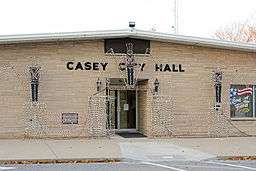Casey, Illinois
| Casey | |
| City | |
 Casey city hall | |
| Nickname: a Small Town with a Big Heart[1] | |
| Country | United States |
|---|---|
| State | Illinois |
| Counties | Clark, Cumberland |
| Townships | Casey, Union |
| Coordinates | 39°17′58″N 87°59′24″W / 39.29944°N 87.99000°WCoordinates: 39°17′58″N 87°59′24″W / 39.29944°N 87.99000°W |
| Area | 2.16 sq mi (6 km2) |
| - land | 2.16 sq mi (6 km2) |
| - water | 0.00 sq mi (0 km2) |
| Population | 2,769 (2010) |
| Density | 1,385.0/sq mi (535/km2) |
| Timezone | CST (UTC-6) |
| - summer (DST) | CDT (UTC-5) |
| Postal code | 62420 |
| Area code | 217 |
  Location of Casey within Illinois
| |
| Wikimedia Commons: Casey, Illinois | |
Casey is a city in Clark and Cumberland counties in the U.S. state of Illinois. The population was 2,762 at the 2010 census.
The Cumberland County portion of Casey is part of the Charleston–Mattoon Micropolitan Statistical Area.
Casey is the home to several Guinness World Record constructions. #BigThingsInASmallTown include Wind Chime, Rocking Chair, Knitting Needles, Crochet Hook, Pitchfork, Golf Tee, Yardstick, Wooden Token, Dutch Wooden Shoes, Mailbox, Pencil and Birdcage.
Geography
Casey is located at 39°17′58″N 87°59′24″W / 39.29944°N 87.99000°W (39.299543, -87.990056).[2] Most of the city lies in Clark County, although a small portion extends into Cumberland County. In the 2000 census, 2,940 of Casey's 3067 residents (99.9%) lived in Clark County and 2 (0.1%) lived in Cumberland County.[3]
According to the 2010 census, Casey has a total area of 2.16 square miles (5.59 km2), all land.[4]
Demographics
| Historical population | |||
|---|---|---|---|
| Census | Pop. | %± | |
| 1880 | 778 | — | |
| 1890 | 844 | 8.5% | |
| 1900 | 1,500 | 77.7% | |
| 1910 | 2,157 | 43.8% | |
| 1920 | 2,189 | 1.5% | |
| 1930 | 2,200 | 0.5% | |
| 1940 | 2,543 | 15.6% | |
| 1950 | 2,734 | 7.5% | |
| 1960 | 2,890 | 5.7% | |
| 1970 | 2,994 | 3.6% | |
| 1980 | 3,026 | 1.1% | |
| 1990 | 2,914 | −3.7% | |
| 2000 | 2,942 | 1.0% | |
| 2010 | 2,769 | −5.9% | |
| Est. 2015 | 2,709 | [5] | −2.2% |
As of the census[7] of 2000, there were 2,942 people, 1,266 households, and 758 families residing in the city. The population density was 1,385.0 people per square mile (535.8/km²). There were 1,454 housing units at an average density of 684.5 per square mile (264.8/km²) 87.The racial makeup of the city was 98.67% White, 0.4% African American, 0.14% Native American, 0.03% from other races, and 0.71% from two or more races. Hispanic or Latino of any race were 0.24% of the population.
There were 1,266 households out of which 28.2% had children under the age of 18 living with them, 44.4% were married couples living together, 12.2% had a female householder with no husband present, and 40.1% were non-families. 36.7% of all households were made up of individuals and 20.2% had someone living alone who was 65 years of age or older. The average household size was 2.22 and the average family size was 2.90.
In the city the population was spread out with 24.1% under the age of 18, 7.9% from 18 to 24, 24.1% from 25 to 44, 20.7% from 45 to 64, and 23.2% who were 65 years of age or older. The median age was 40 years. For every 100 females there were 80.3 males. For every 100 females age 18 and over, there were 74.5 males.
The median income for a household in the city was $30,089, and the median income for a family was $36,941. Males had a median income of $30,809 versus $16,496 for females. The per capita income for the city was $16,266. About 11.5% of families and 15.4% of the population were below the poverty line, including 20.6% of those under age 18 and 10.1% of those age 65 or over.
Notable people
- David Hanners, 1989 Pulitzer Prize winner[8]
- 1st Lieutenant Paul Conrad Burrus (USMC Infantry Officer), KIA MIA leading a patrol of E Company, 2/1 Marines at Harlow Hill, Kumgok, Korea (Korean War), December 26, 1952.[9] The Paul C. Burrus Habitat Area, located near the village of Hutton, Illinois, is named in his honor.[10]
See also
References
- ↑ http://cityofcaseyil.org/
- ↑ "US Gazetteer files: 2010, 2000, and 1990". United States Census Bureau. 2011-02-12. Retrieved 2011-04-23.
- ↑ "Subcounty population estimates 2000-2006: Illinois" (CSV). United States Census Bureau, Population Division. 2007-06-28. Retrieved 2008-06-08.
- ↑ "G001 - Geographic Identifiers - 2010 Census Summary File 1". United States Census Bureau. Retrieved 2015-12-25.
- ↑ "Annual Estimates of the Resident Population for Incorporated Places: April 1, 2010 to July 1, 2015". Retrieved July 2, 2016.
- ↑ "Census of Population and Housing". Census.gov. Archived from the original on April 22, 2013. Retrieved June 4, 2015.
- ↑ "American FactFinder". United States Census Bureau. Archived from the original on 2013-09-11. Retrieved 2008-01-31.
- ↑ Bennett, Mark (10 October 2007). "Wabash Valley native, Pulitzer Prize winner writes song on Fontanet powder mill explosion". TribStar. Retrieved 26 May 2012.
- ↑ US Marines in Korea, Vol. 1: 1952 by Lee Ballenger
- ↑ State of Illinois Hunters Guide
